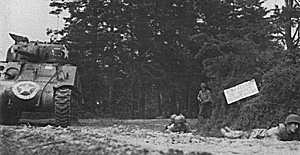 This article will discuss rules designed for company-level actions and above; a future article will deal with twentieth century skirmish rules. There are a large number of rule sets available - most can be obtained from your local game dealer. Though the rules surveyed here are all currently available, there are numerous other sets that are currently out of print, that I've been unable to obtain, or am simply unaware of!
This article will discuss rules designed for company-level actions and above; a future article will deal with twentieth century skirmish rules. There are a large number of rule sets available - most can be obtained from your local game dealer. Though the rules surveyed here are all currently available, there are numerous other sets that are currently out of print, that I've been unable to obtain, or am simply unaware of!
France 1944: 29th Division moves out of the Normandy Beachhead area.
The following charts address seventeen sets of rules - ten WWII era and seven postwar era. Certain features are common to all of the rules. With one exception, all ofthe sets separate hit and damage resolution. Hits are resolved by die-roll, modified for range and other factors. Units have fixed movement allowances, modified by terrain, etc. Certain features vary widely (wildly?) from rule set to rule set. Two different kill mechanisms are used. Spotting and acquisition tables vary from nonexistant to very detailed. Numerous other basic game aspects are treated fully, nominally, or not at all.
Morale and Command Control are handled with varying degrees of success by the various rule sets. The newer sets tend to treat these aspects of the rules with more respect than the older sets do - this reflects the increased attention paid by gamers in recent years.
Another topic treated with varying degrees of success is armor slope, more of a factor in the WWII rules than with the postwar era rules. All of the rules recognize that thicker armor gives better protection than does thinner armor, given consistent armor quality. However, some of the rules don't recognize that increased slope increases the effective thickness of the armor, which leadsto someodd equipment comparisons, causing distortions in the relative strengths of vehicles within those rule sets. Fortunately, most of the newer rules do properly address armor slope.
Sighting is handled in one of two ways by most of the rules. The simpler method is deterministic - when a target approaches within a certain range of the sighting unit, the target is spotted. This has the virtue of speeding play, and is easier to use. It has the disadvantage that many battlefield tactics simply don't work when units are automatically sighted. The other sighting method used is probablistic - at a given range, the sighting unit has a given chance to see the target. This is a bit slower (players are continually making sighting die rolls), but allows much more limited battlefield intelligence, especially when a referee is not available.
All of the rules surveyed deal adequately with infantry, artillery, and (with one exception), airpower. Any peculiarities regarding these rules are dealt with in the notes following the Survey Charts. As may be expected, most of the postwar era rules address airpower more extensively than their WWII counterparts, in keeping with airpower's enhanced capabilities with respect to, and closer integration into, the modern battlefield. Engineering, as noted on the charts, is included to varying degrees, ranging from simple minefield use to construction and fortification.
By and large, ground and time scales don't vary much from rule setto rule set, as all but three of the sets place the player in the position of a company or battalion commander, with primary focus on the former. COMMAND DECISION, 1944, and CORPS COMMANDER all place the player at a battalion/brigade/clivision level. The flavor of these rule sets, due to the types of play decisions made by the player, is quite different from the other (tactical) sets, but is by no means less enjoyable.
Three broad play sequences are employed by the rules surveyed. The first, and oldest, is pure sequential movement (SEQ-A) - you move and fire all of your units, then I move and fire all of mine. This is the simplest to use, but is also the least satisfactory in terms of showing battlefield interaction. Interactive sequential movement (SEQ-B) and simultaneous movement (SIMOV) both allow the full gamut of battlefield encounter and action/reaction. The former allows a slightly more ordered game and the latter, a slightly more freewheeling one, but both work well.
Explanations of the Survey Chart titles, and notes on the individual rule sets follow the charts. One title must be addressed here. Complexity, given a range of 1-5, is not an inclicatorof gameworth. It is an inclicatorof how much effort is required to play the game. Game detail does correlate roughly to complexity, but it is not a firm or fixed relationship.
More 20th C. Land Battle Rules A Survey
Back to Table of Contents -- Courier Vol. VII #5
To Courier List of Issues
To MagWeb Master Magazine List
© Copyright 1987 by The Courier Publishing Company.
This article appears in MagWeb (Magazine Web) on the Internet World Wide Web.
Other military history articles and gaming articles are available at http://www.magweb.com